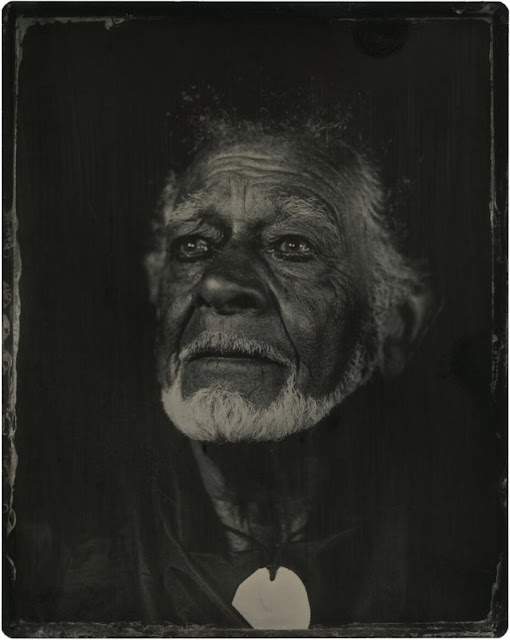Exhibition Review: Photography | Brian Rope
2024
National Photographic Portrait Prize | Various Artists
National Portrait Gallery, Canberra | 22 June – 13 October 2024
The National Portrait Gallery (NPG) website says the works by the 34 selected finalists in the National Photographic Portrait Prize (NPPP) this year provide a powerful visual record of the year, reflecting a particular time in Australian culture.
The selected winning work is Alexis with moon, 2024 by Amos Gebhardt and is a diptych – on the left we see something of the moon, on the right is author Alexis Wright. The judges “were taken by the sparse, yet powerful relationship created between the moon, the subject and the camera.” They said, "Wright is a noted First Nations author whose work collapses linear time and connects to ideas of the cosmos, and Gebhardt’s portrait, lit only by the moon, speaks directly to the sitter’s work."
 |
| Alexis with moon 2024 © Amos Gebhardt |
Unsurprisingly, some think a different finalist should have been chosen, some don’t like, or don’t understand, it. I do like the work and am quite content with its selection. Along with numerous others, it illustrates how approaches have substantially changed over the years.
Whilst most of the exhibited works are pigment photographic prints on paper, one of them is in a kiln cast glass frame and another is from Polaroid Type 665 film. One work is a cyanotype, two are prints of original wet plate collodion process tintypes. There is a type C print and a digital type C print. Also there is a dye sublimation print on aluminium, and a UV print on glass, hand-cut glass, silicone on aluminium.
There are five Canberra and region finalists. Zoe Helene Karouzos has Mikayla with her brothers 2023 - a casual portrait of four tired siblings. Karouzos is an Australian/Greek photographer working on Ngunnawal/Ngambri Country in Kamberri/Canberra. Her work explores the intricacies and importance of interpersonal relationships, genealogy and our emotional connection to ancestors.
 |
| Mikayla with her brothers 2023 © Zoe Helene Karouzos |
Prue Hazelgrove’s She 2023 is one of the original wet plate collodion process tintypes. Hazelgrove is a queer artist based on Ngunnawal/Ngambri Country in Gundaroo, who specialises in that process, using it to represent stories erased from conventional narratives, asking viewers to consider their biases and beliefs. This and other works in the exhibition certainly do require viewers to think about their beliefs.
 |
| She 2023 © Prue Hazelgrove |
Brenda Louise Croft’s Men of High Degree: Jim Everett – puralia meenamatta (clan plangermairreenner, Ben Lomond people, Cape Portland nation, north-east Tasmania) 2023 is the other original wet plate collodion process tintype. Indeed, Hazelgrove was Croft’s technical assistant for this artwork. It is also a powerful portrait and very much the style of work we have come to expect from this artist.
 |
| Men of high degree Jim Everett - etc 2023 © Brenda L Croft, Prue Hazelgrove |
Tamara Henderson’s work is the one in the kiln cast glass frame, a standout artwork in itself. Green in the Grooves 2023 is a still taken from a 16mm film. In this photographic frame the artist was under a pane of glass and soil was progressively scattered onto the glass. Henderson is an artist based on Ngunnawal/Ngambri Country in Kamberri/Canberra whose work draws attention to the often-unappreciated earth beneath our feet, the grounding of life on this planet.
 |
| Green in the Grooves 2023 © Tamara Henderson |
Based on Walbunja Country, Dean Cross is an artist and Worimi man through his paternal bloodline. Old growth/New growth 2023 is a powerful in-your-face portrait of his naked wife, made in an old growth forest four days before the birth of their twins.
 |
| Old growth/New growth 2023 © Dean Cross |
I can’t conclude without mentioning the work on hand-cut glass. Maman Simin 2023 by Ali Tahayori. This final photograph of her grandmother before she died was printed on clear glass, then broken by hand, and reassembled to create a whole that is greater than the sum of its parts. The image and the process together have produced a fine artwork.
 |
| Maman Simin 2023 © Ali Tahayori |
I very much agree that the works on exhibition reflect much of Australians as we are at this time in our history. There are works by and about a range of Australians – young and old, Indigenous, ordinary people, the marginalised, migrants, various gender identities. The subject matter is most interesting and diverse.
This review is also available on the author's blog here and in the August 2024 issue of The Printer here.